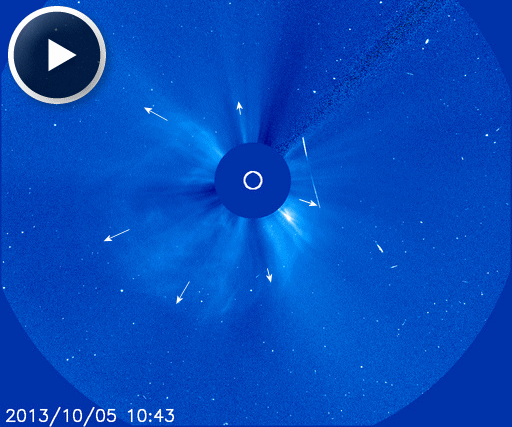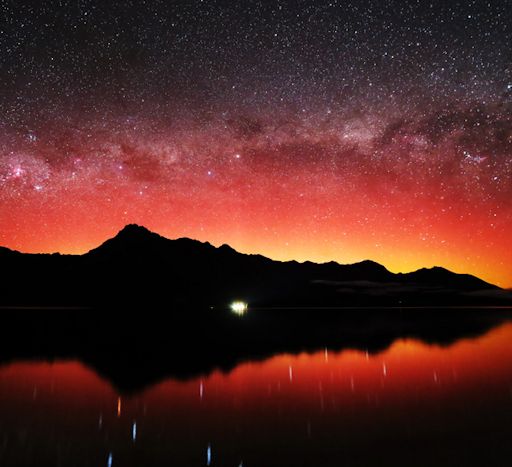JUNO SPACECRAFT TO FLY BY EARTH: Here's some news you might not hear from NASA because, like much of the US government, the space agency is closed. NASA's Juno spacecraft will slingshot past Earth on October 9th for a velocity boost en route to Jupiter. At closest approach the spacecraft will be only 347 miles from Earth as it gains an extra 16,000 mph for the long journey ahead. Update: During the flyby, Juno's science instruments will sample the Earth environment--a practice run for data-taking at Jupiter years from now. Fortunately, commands to activate Juno's sensors were uploaded before the shutdown. The science experiment can proceed. Radio amateurs are encouraged to beam a message to Juno during the flyby. Juno will be listening.
FARSIDE CORONAL MASS EJECTION: The Earthside of the sun is quiet, but the farside of the sun is not. During the early hours of Oct. 5th, NASA's STEREO-A probe, stationed over the farside, recorded the eruption of a southern hemisphere sunspot. Shortly after 07:30 UT, a coronal mass ejection (CME) flew over the sun's southeastern limb (credit: SOHO):
Radio emissions from shock waves in the CME suggest an expansion velocity of about 700 km/s (1.6 million mph), which is fairly typical of CME speeds. If Earth were in the line of fire, we would probably observe bright polar auroras in a few days. However, this CME is heading away from, not toward our planet.
The active region that produced the blast will rotate onto the Earthside of the sun in about 7 days. If it remains potent, geoeffective solar activity could increase late next week. Solar flare alerts: text, voice.
RED AURORAS: On October 2nd, a CME hit Earth's magnetic field, sparking a G2-class geomagnetic storm. Sky watchers on both ends of the Earth saw auroras; many of the lights were rare shades of red. Minoru Yoneto photographed this example from Queenstown, New Zealand:
"This is how the sky looked 11 hours after the CME impact," says Yoneto, who used a Canon EOS 6D digital camera to record the reds.
Auroras are usually green, and sometimes purple, but seldom do sky watchers see this much red. Red auroras occur some 300 to 500 km above Earth's surface and are not yet fully understood. Some researchers believe the red lights are linked to a large influx of electrons. When low-energy electrons recombine with oxygen ions in the upper atmosphere, red photons are emitted. At present, space weather forecasters cannot predict when this will occur.
During the storm, even more red auroras were observed over the United States in places like Kansas, Ohio, and Oklahoma. Browse the gallery for examples. Aurora alerts: text, voice.

Solar wind
speed: 325.4 km/sec
density: 1.1 protons/cm3
explanation | more data
Updated: Today at 2027 UT
X-ray Solar Flares
6-hr max: B3 1846 UT Oct05
24-hr: B5 0441 UT Oct05
explanation | more data
Updated: Today at: 2000 UT
![]()
Daily Sun: 05 Oct 13
None of these sunspots is actively flaring. Solar activity is low. Credit: SDO/HMI
![]()
Sunspot number: 84
What is the sunspot number?
Updated 05 Oct 2013
Spotless Days
Current Stretch: 0 days
2013 total: 0 days (0%)
2012 total: 0 days (0%)
2011 total: 2 days (<1%)
2010 total: 51 days (14%)
2009 total: 260 days (71%)
Since 2004: 821 days
Typical Solar Min: 486 days
Update 05 Oct 2013
The Radio Sun
10.7 cm flux: 109 sfu
explanation | more data
Updated 05 Oct 2013
![]()
Current Auroral Oval:
Switch to: Europe, USA, New Zealand, Antarctica
Credit: NOAA/POES
![]()
Planetary K-index
Now: Kp= 1 quiet
24-hr max: Kp= 1 quiet
explanation | more data
Interplanetary Mag. Field
Btotal: 1.2 nT
Bz: 0.3 nT north
explanation | more data
Updated: Today at 2027 UT
![]()
Coronal Holes: 05 Oct 13
Solar wind flowing from this coronal hole should reach Earth on Oct. 9-11. Credit: SDO/AIA.






